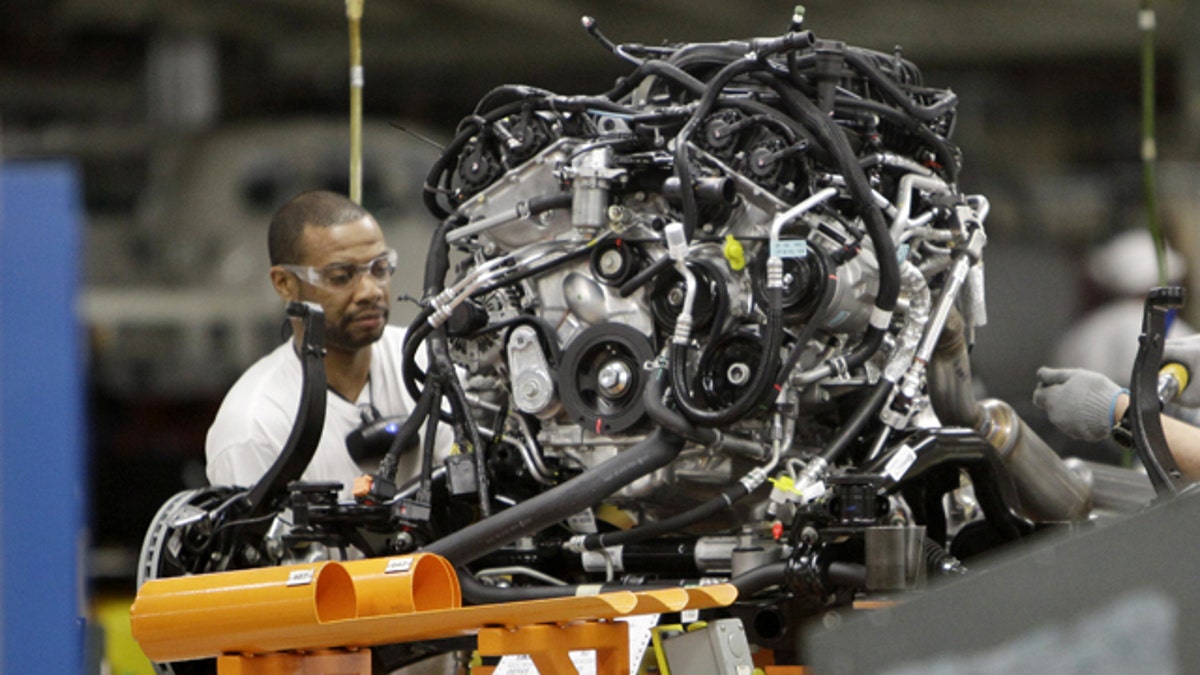
FILE - In this April 28, 2011 file photo, an assemblyman works on an engine for the Chrysler Jeep or the Dodge Durango which are built on the same line at Chrysler's Jefferson North Assembly Plant in Detroit. The company reported first-quarter net income of $116 million and revenues of $13.1 billion on Monday, May 2, 2011. The profit is a milestone in Chrysler's long road back to health after its 2009 bankruptcy. It last reported a profit in 2007. (AP Photo/Carlos Osorio) (AP)
DETROIT – Chrysler has turned its first profit since leaving bankruptcy two years ago.
The company reported first-quarter net income of $116 million and revenue of $13.1 billion on Monday. The profit is a milestone in Chrysler's long road back to health after its 2009 bankruptcy. It last reported a net profit in 2006.
Chrysler's return to profitability is also another chapter in the comeback of the Detroit Three automakers. General Motors Co., which also went into bankruptcy in 2009 and took government loans, has reported a string of profitable quarters and held an initial public offering in November. Ford Motor Co., which didn't take bailout money but nearly had to file for bankruptcy five years ago, reported its eighth consecutive quarterly profit last week.
Several trends put Detroit's automakers — and Chrysler in particular — back in the black. Sales are rising as the economy improves, and each of the companies has released popular new products. Chrysler's sales rose 18 percent worldwide in the first three months of the year.
"Chrysler Group's improved sales and financial performance in the first quarter show that our rejuvenated product lineup is gaining momentum in the marketplace and resonating with customers," Chrysler CEO Sergio Marchionne said in a statement.
Momentum is crucial. Chrysler wants to hold an initial public offering later this year or early next, but investors must first see a string of profitable quarters.
Chrysler's new vehicles caught buyers' eyes in the latest quarter. U.S. sales of the revamped Jeep Grand Cherokee SUV jumped 64 percent, while sales of the Chrysler 200 sedan more than quadrupled over those of its predecessor, the Sebring.
Chrysler said buyers were willing to pay more for its cars and trucks. Edmunds.com estimates the company lowered incentive spending by nearly $1,000 per vehicle in the quarter. Revenues rose 35 percent.
Chrysler last reported a profitable quarter in 2006, one year before it was sold by Daimler AG to private-equity firm Cerberus Capital Management.
Cerberus didn't invest the cash needed to weather the worst auto sales decline in more than 25 years, and as a result, Chrysler came close to running out of money at the end of 2008. The U.S. government stepped in, authorizing $10 billion in aid and appointing Marchionne to run the company after it emerged from bankruptcy protection in June 2009.
The U.S. government remains a part owner of Chrysler, holding an 8.6 percent stake. But Chrysler is trying to sever those ties. Last week, the company said it will soon repay $7.5 billion of the bailout from the U.S. and Canadian governments using a new, $3.5 billion bank loan and $1.5 billion credit facility and a $2.5 billion debt offering. The move will save Chrysler millions in interest payments. Its government loans carry an average interest rate of 12 percent and cost the company $1.2 billion in interest last year.
The U.S. government is also expected to recoup some of the bailout money when it sells its stock in the public offering.
Chrysler isn't out of the woods. The company still depends on sales of trucks and SUVs, and rising gas prices will likely hurt sales. The company doesn't currently have a hybrid or a small car that gets 40 miles per gallon, as competitors Hyundai, Ford, General Motors and Toyota do. And some competitors are gaining U.S. market share at a faster rate than Chrysler, including Nissan and Kia.
But that's not keeping some from feeling bullish about its future. Last month, Fiat SpA, which is also run by Marchionne, gave Chrysler a vote of confidence when it said it will spend $1.3 billion to raise its stake in the American company. That will increase Fiat's holdings from 30 percent to 46 percent.